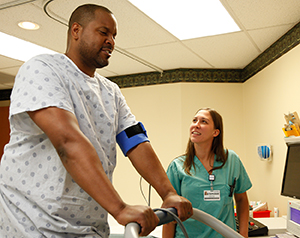A stress echocardiogram is also called a stress echo. It's a test that records pictures of your heart before and after you exercise. During activity, your heart has to work harder to send oxygen-rich blood all over your body. This test helps your healthcare provider see if your heart is working well when you're active. The test will take 1 to 2 hours from the time you arrive to when you can leave.
Before your test
-
When you schedule your test, mention all prescription and over-the-counter medicines you take. This includes vitamins, herbs, and other supplements. Ask if it’s OK to take them before your test. Some medicines can affect blood flow to the heart and the heart rate. This can affect the test results. You may be asked to wait until after the test is done before you take your normal doses of these types of medicines.
-
Talk about any questions or concerns with your healthcare provider.
-
Allow extra time to check in. Bring your insurance cards, identification, and any co-payments that are required for the test.
-
Follow any directions you're given for not eating or drinking before the test. Don't drink any caffeine for 12 hours before the test, or as directed by your healthcare provider. If you use tobacco, you may also be asked not to use it the day of the test. This includes cigarettes, electronic cigarettes, chew, and nicotine gum. Stimulating the heart with these substances can affect your test results.
-
Wear flat, comfortable walking or running shoes.
-
Wear a top you can take off easily. You may be asked to remove your clothing from the waist up. You'll be given a hospital gown to wear.
-
An IV (intravenous) tube may be put into a vein in your arm or hand if contrast dye is injected during the study.
During your test
Echo uses a small device (probe or transducer) that makes sound waves. It sends images of your heart to a video screen. The images are recorded:
-
A special gel is put on your chest. The probe is moved over the gel. This records your heart at rest. If you're overweight, the technician may have to press down harder to get better images. This can be uncomfortable. Tell your technician if you're uncomfortable.
-
Medical staff will take your blood pressure. You'll also have an electrocardiogram (ECG). For this test, small pads (electrodes) are placed on your chest. The ECG reads the pattern of your heartbeat.
-
Next, you’re asked to walk or run on a treadmill. Or you may use a stationary bike. You’ll do this until your heart beats fast. Note: If you can't exercise, you’ll be given a medicine to get your heart working harder. This medicine can make you feel short of breath.
-
You stop exercising. Right away, the probe is used to take a second set of video images of your heart. Your healthcare provider compares these images with the first ones taken.
-
The technician may use IV contrast for better images.
During the test, tell the provider if you feel any chest, arm, or jaw discomfort. Also tell them if you have severe shortness of breath, feel very tired, or feel dizzy. The test may be stopped if you have severe or lasting symptoms with exercise. It may be stopped if there are any changes in your vital signs or heart rhythm.
After the test
You can go back to your normal daily routine. Keep your follow-up appointment with your healthcare provider to discuss your test results.
Your next appointment is: _______________________



